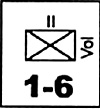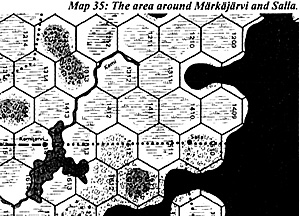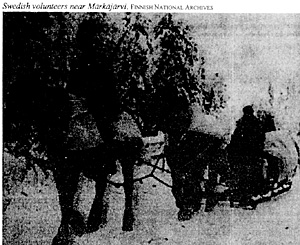 At the outbreak of the Finnish Winter War in the autumn of
1939, a strong opinion arose in Sweden for the Finnish cause. Almost
immediately, a special bureau was organized to recruit a large volunteer
force to fight with the Finns. During December 1939, this bureau organized
many activities in support of the Finnish struggle, such as soirdes, money
collections, winter clothing collections and a campaign to recruit Swedish
volunteers under the motto "Finland's cause is ours!"
At the outbreak of the Finnish Winter War in the autumn of
1939, a strong opinion arose in Sweden for the Finnish cause. Almost
immediately, a special bureau was organized to recruit a large volunteer
force to fight with the Finns. During December 1939, this bureau organized
many activities in support of the Finnish struggle, such as soirdes, money
collections, winter clothing collections and a campaign to recruit Swedish
volunteers under the motto "Finland's cause is ours!"
There was a tremendous interest in taking part in this force, but there were also bureaucratic problems since the Swedish government would not be openly involved in the war. At the same time, the Swedish government began its own draft program to enlarge the tiny peacetime Swedish army. Because of this draft, many who had made a preliminary application to the Volunteer Corps were instead called under the Swedish flag. By December 18, there were only 1059 recruits instead of the anticipated 7500.
The Finnish counterattacks of mid-December through mid-January proved Finland could give the Soviets a fight and persuaded the Swedish government to allow the bureau a freer hand in recruiting.
Government cooperation immediately increased the bureau's success. By February 6, 1940 the Volunteer Corps counted its strength at 5500. Almost 100 persons per day were asking for enlistment.
By the end of the Winter War, 12,705 Swedes had volunteered. Of these, 8,260 were regarded as "fit for service in northern Finland." To this number should be added 727 Norwegians. Aside from the Volunteer Corps, almost 500 Swedes served in regular Finnish units.
Forming at Tornea and Kemi: December 1939 - February 1940
The commander of the 1st Group, Lt. Col. Magnus Dyrssen left Stockholm with a reconnaissance force of 85 soldiers for Kemi (5B:2704; 35:1819) on December 22. In Tomea, they were met by the colorful commander of 3rd Group, Col. Martin Ekstrom. This officer had served in Persia, and in the Estonian, Lithuanian, and Finnish wars of liberation, even winning recognition as "the Conqueror of Narva" in the Estonian War of Liberation.
During this period, the volunteers began to arrive and were organized into their companies. A tight schedule of military training began. Everyone was eager to leave for the front, but many had little or no military training. The training included combat exercises, practice shooting, skiing, handling horses and cars in cold weather and, of course, even more skiing.
During this period, the Finnish HQ debated how best to employ the corps. To avoid placing the Swedish commander under direct Finnish command at the Karelian Isthmus, Field Marshal Mannerheim decided to make the commander of the Volunteer Corps report to the supreme commander in northern Finland. (roughly above the "A" weather line in Europa terms).
This arrangement satisfied both the Swedish HQ and General Linder, the Corps commander, who now received an independent command. The corps could cooperate with the Swedish Army forces guarding the Swedish / Finnish frontier, should the Soviets break through and advance against Sweden.
Swedish Volunteer Corps Organization
Group HQ with a staff company and a signal company
3x groups (corresponding to reinforced battalions) each with:
- 1x staff company
3x rifle companies
1x light "jaeger" company
1x heavy weapons company
1x 75mm/m 02 howitzer company (horsedrawn with 4 guns)
1x special "plough platoon" to prepare battery emplacements and make roads trafficable to wheeled vehicles
2x motorized antitank platoons
1 x independent jaeger company
1x independent engineer company
1x independent anti-aircraft company with 6 sections, each with 2 Bofors 40mm AA guns for a total of 12 guns
1x independent 75mm AA battery with 6 guns
The rifle companies were each composed of:
- 3x rifle platoons with 3 rifle sections and an antitank
section each (2x 13 mm AT rifles in each AT section)
1x heavy weapons platoon with 3 HMG m/14, 2x 20mm AT guns, 2x 80 mm mortars m/29
Each jaeger company consisted of:
- 3x light platoons of 4 sections each
1x heavy section with 4 light machine guns and 3 AT rifles
Each heavy weapons company consisted of:
- 1x LMG platoon with 9 HMGs
1x AT platoon with 4x 20mm AT guns
1x mortar platoon with 3x 80mm mortars
In support of the Corps in the rear areas:
- 1x supply company
1x ammunition company
1x line of communications company
2x transportation companies with wheeled cars
1x transport company with horses and sledges
1x military police company
2x field hospital platoons
1x field repair company
For air cover, the 19th squadron with 6 Italian-built CR.42 fighters and 4 German-built Ju86 bombers was attached.
To the Front: February 3 - February 25, 1940
On February 3, 1940, 1st Group began a march on skis to the front. This was not the fastest way to get there, but it was the final graduation exercise of the troops and their commanders. During mid-February, the cold was indeed severe, with several days of 40 C temperatures.
The route passed Rovaniemi and on the 24th the Group commander began to discuss the relief of the Finnish 40th Infantry Regiment with the Finnish sector commander.
On the 27th, the 1st Group took up positions at Wirktijdrvi (6A:2427; 35:1511), on the road to Salla, with 2nd Company north of the road, 1st and 3rd south of it, and the 4th (Jaeger) company in reserve.
The 2nd Group formed at Kemi and left by train to Kemijarvi, where it began arriving on February 19. The group was ordered to begin relieving Finnish units during the night of February 24/25th. To avoid Soviet aircraft, the Group moved on skis through the terrain north of the road. It was not a very long distance, about 28 km to Joutsijarvi (6A:2428; 35:1512), but none of the Volunteers who took part in that march will ever forget it. Leading was the plough platoon, marking tracks for the rest of the Group to follow. After only 10 km, it became clear that the leading element had gotten lost, going south of two large lakes. This made an extra 10 kms. At the same time, the temperature fell to below -45 C. On reaching Joutsiijarvi, more than 80 of the 1400 soldiers of 2nd Group had severe frostbite and had to be brought to hospital. Many others had lighter cases of frostbite.
 Map 35. The area around Markajarvi and Salla.
From Joutsijarvi the Group traveled by truck to the front
at Markajarvi, where it took up positions 2.5 kin north of 1st
Group (6A:2327; 35:1410).
Map 35. The area around Markajarvi and Salla.
From Joutsijarvi the Group traveled by truck to the front
at Markajarvi, where it took up positions 2.5 kin north of 1st
Group (6A:2327; 35:1410).
At the Front: February 28 - March 13, 1940
The days following the relief of the Finns were busy. The Groups prepared positions for "active defense", counterattacks and patrol attacks in different directions.
Opposite the Swedish volunteers were the Soviet 122nd Rifle Division (6A:2326, 2426, 2526; 35:1409, 1510, 1609) with 420th and 715th Rifle Regiments at the front and 596th Rifle Regiment in reserve. Around Markajarvi, the Soviets also had deployed the 153rd Special Recon Battalion with 3 recon companies and also the 2nd Border Guard Regiment.
The first days at the front saw little action from the Soviet side, except for sudden brief artillery and mortar concentrations.
During the first days of March, the Volunteers began to patrol the front. The task for the patrols was to locate the Soviet resistance nests and strongpoints, and of course to find possible attack routes. On March 1, the commander of 1st Group, Lt. Col. Dyrssen was the first Swedish casualty. During an inspection at 1st Company, Lt. Col. Dyrssen was hit in his head with shell fragments and died instantly.
On the same day, Cpt. Anders Grafstrom of the jaeger company of the 2nd Group, led a reconnaissance on the Soviet northern flank, to see if it was possible to make an attack with two battalions, supported by heavy weapons.
The company left the reserve area at 0700, March 1. At 0230, they reached the "base area" NE of Tennusjarvi (6A:2225/2226; 35:1309/1310), where the company took up positions on a small hill in a wooded swamp area. Five different patrols were sent out in the general direction of the Salla-Markajarvi road, to count traffic and to reconnoiter advance routes.
At 1330, a Soviet force of 60 soldiers with heavy weapons approached. The Soviets advanced with 10 meter intervals and were good skiers. A detachment of 8 men with a medium machine gun moved towards the positions of the jaegers and deployed a machine guns on the small hill. After a brief firefight, the Swedes annihilated this tiny detachment. The Soviets deployed for support and after some 5 minutes opened fire from north and east with more machine guns. About 50 Soviets began to close on the Swedish positions. This fight lasted for about 45 minutes, when the Soviets were reinforced by another half company. At the same time, shooting was heard from the southeast. This was probably the last patrol, which had not returned yet.
At 1630, the Soviets were reinforced by another company, some 150 men with automatic rifles. About 1800, the Soviets started another attack with some 30 men. The Swedes made a counterattack with three sections, killing some 150 Soviets and capturing nine machine guns.
This counterattack was stopped just at the Soviet line and the Swedes again lost the initiative. Swedish casualties were six dead and five wounded, but one entire patrol (2nd Lt. Ojstad and seven men) had to be reported missing in action. Three of them were killed in the firefight that was heard from the southeast. Three others were wounded and captured. The Soviet casualties included at least 200 dead from 420th Rifle Regt of 122 Rifle Div.
 Swedish volunteers near Markajarvi. FINNISH NATIONAL ARCHIVES
On March 8, a second company-scale patrol was sent out
to scout the Soviet southern flank around the steep hill of
Ristelivaara. On top of the hill (6A:2526; 35:1609) a Soviet
recon detachment was deployed, including an observation
balloon. The commander of 1st Group decided to eliminate the
observation post with a two-company attack before continuing
the reconnaissance further to the south.
Swedish volunteers near Markajarvi. FINNISH NATIONAL ARCHIVES
On March 8, a second company-scale patrol was sent out
to scout the Soviet southern flank around the steep hill of
Ristelivaara. On top of the hill (6A:2526; 35:1609) a Soviet
recon detachment was deployed, including an observation
balloon. The commander of 1st Group decided to eliminate the
observation post with a two-company attack before continuing
the reconnaissance further to the south.
However, the Soviets reacted a bit quicker than the Swedes and mounted their own company-sized attack against 2nd Group on March 10. The attack began at 1515 on the right flank of the 2nd company but was halted by Swedish machine gun fire (along hexside 6A:2527/2427; 35:1511/1610).
At 1500 hrs, the Soviets intensified their attack with fresh troops and heavy weapons. The 1st Company, 2nd Group was on their skis, ready to move to outflank the enemy. At 1700 hours, the Soviets tried to push forward again. Swedish mortar fire halted this attack. A jaeger platoon made an outflanking movement to the south at 2030 hrs, and deployed for an ambush against expected Soviet reinforcements. At 2200 hrs they opened fire, killing some 50 Soviets before withdrawing. One Swedish and one Norwegian volunteer were killed in this brief firefight.
March 1940: The End of the Winter War
Early on March 12, rumors of an armistice began to circle. These rumors were confirmed at 1030 on the field phone by the corps commander. The Soviets began a heavy shelling of the Swedish positions in the morning. This continued until just before 1100 when it suddenly stopped, announcing the end of the war.
The corps began disbanding soon after the official confirmation of the armistice. On March 26, Field Marshal Mannerheim received the corps at Paikanselka for an official reward ceremony where he awarded several "Crosses of Freedom" to distinguished Volunteers. However, a jaeger company's war diary reveals that ". . most of the decorations went to the Corps and Group-level staffs and only a few to the front- line soldiers".
The Continuation War of 1941: "The Hanko Battalion"
Back to Europa Number 46 Table of Contents
Back to Europa List of Issues
Back to MagWeb Master Magazine List
© Copyright 1996 by GR/D
This article appears in MagWeb.com (Magazine Web) on the Internet World Wide Web. Other articles from military history and related magazines are available at http://www.magweb.com